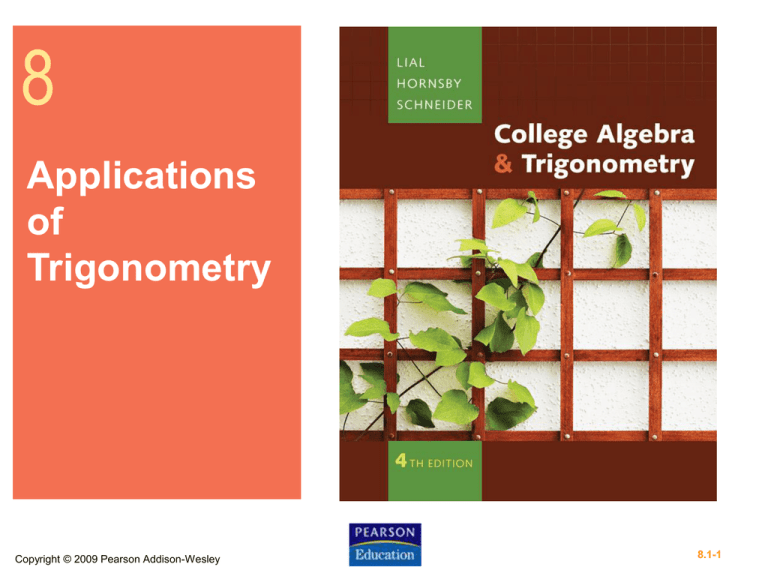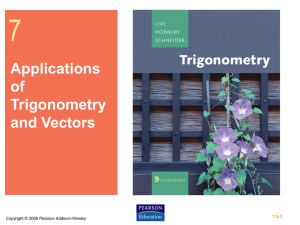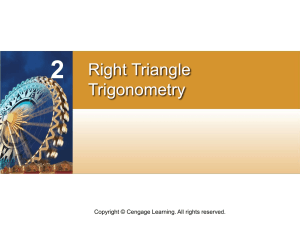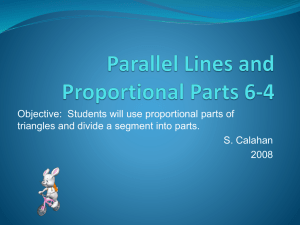
8
Applications
of
Trigonometry
Copyright © 2009 Pearson Addison-Wesley
8.1-1
8 Applications of Trigonometry
8.1 The Law of Sines
8.2 The Law of Cosines
8.3 Vectors, Operations, and the Dot Product
8.4 Applications of Vectors
8.5 Trigonometric (Polar) Form of Complex
Numbers; Products and Quotients
8.4 De Moivre’s Theorem; Powers and Roots of
Complex Numbers
8.5 Polar Equations and Graphs
8.6 Parametric Equations, Graphs, and
Applications
Copyright © 2009 Pearson Addison-Wesley
8.1-2
8.1 The Law of Sines
Congruency and Oblique Triangles ▪ Derivation of the Law of
Sines ▪ Using the Law of Sines ▪ Ambiguous Case ▪ Area of a
Triangle
Copyright © 2009 Pearson Addison-Wesley
1.1-3
8.1-3
Congruence Axioms
Side-Angle-Side (SAS)
If two sides and the included angle of
one triangle are equal, respectively, to
two sides and the included angle of a
second triangle, then the triangles are
congruent.
Angle-Side-Angle (ASA)
If two angles and the included side of
one triangle are equal, respectively, to
two angles and the included side of a
second triangle, then the triangles are
congruent.
Copyright © 2009 Pearson Addison-Wesley
1.1-4
8.1-4
Congruence Axioms
Side-Side-Side (SSS)
If three sides of one triangle are equal,
respectively, to three sides of a second
triangle, then the triangles are
congruent.
Copyright © 2009 Pearson Addison-Wesley
1.1-5
8.1-5
Oblique Triangles
Oblique triangle
A triangle that is not a right
triangle
The measures of the three sides and the three
angles of a triangle can be found if at least one
side and any other two measures are known.
Copyright © 2009 Pearson Addison-Wesley
8.1-6
Data Required for Solving Oblique Triangles
Case 1 One side and two angles are
known (SAA or ASA).
Case 2 Two sides and one angle not
included between the two sides
are known (SSA). This case may
lead to more than one triangle.
Case 3 Two sides and the angle included
between the two sides are known
(SAS).
Case 4 Three sides are known (SSS).
Copyright © 2009 Pearson Addison-Wesley
1.1-7
8.1-7
Note
If three angles of a triangle are
known, unique side lengths cannot
be found because AAA assures only
similarity, not congruence.
Copyright © 2009 Pearson Addison-Wesley
1.1-8
8.1-8
Derivation of the Law of Sines
Start with an oblique triangle,
either acute or obtuse.
Let h be the length of the
perpendicular from vertex B
to side AC (or its extension).
Then c is the hypotenuse of
right triangle ABD, and a is
the hypotenuse of right
triangle BDC.
Copyright © 2009 Pearson Addison-Wesley
8.1-9
Derivation of the Law of Sines
In triangle ADB,
𝒉
𝐬𝐢𝐧 𝑪 = 𝒐𝒓 𝒉 = 𝒂 𝐬𝐢𝐧 𝑪
𝒂
Since h = c sin A and h = a sin C,
Copyright © 2009 Pearson Addison-Wesley
8.1-10
Derivation of the Law of Sines
In triangle BDC,
Similarly, it can be shown that
and
Copyright © 2009 Pearson Addison-Wesley
8.1-11
Law of Sines
In any triangle ABC, with sides a, b, and c,
Copyright © 2009 Pearson Addison-Wesley
1.1-12
8.1-12
Example 1
USING THE LAW OF SINES TO SOLVE A
TRIANGLE (SAA)
Solve triangle ABC if
A = 32.0°, C = 81.8°,
and a = 42.9 cm.
Law of sines
Copyright © 2009 Pearson Addison-Wesley
1.1-13
8.1-13
Example 1
USING THE LAW OF SINES TO SOLVE A
TRIANGLE (SAA) (continued)
A + B + C = 180°
C = 180° – A – B
C = 180° – 32.0° – 81.8° = 66.2°
Use the Law of Sines to find c.
Copyright © 2009 Pearson Addison-Wesley
1.1-14
8.1-14
Example 2
USING THE LAW OF SINES IN AN
APPLICATION (ASA)
Kurt wishes to measure the distance across the Big
Muddy River. He determines that C = 112.90°,
A = 31.10°, and b = 347.6 ft. Find the distance a
across the river.
First find the measure of angle B.
B = 180° – A – C = 180° – 31.10° – 112.90° = 36.00°
Copyright © 2009 Pearson Addison-Wesley
1.1-15
8.1-15
Example 2
USING THE LAW OF SINES IN AN
APPLICATION (ASA) (continued)
Now use the Law of Sines to find the length of side a.
The distance across the river is about 305.5 feet.
Copyright © 2009 Pearson Addison-Wesley
1.1-16
8.1-16
Example 3
USING THE LAW OF SINES IN AN
APPLICATION (ASA)
Two ranger stations are on an
east-west line 110 mi apart. A
forest fire is located on a bearing
N 42° E from the western station at
A and a bearing of N 15° E from
the eastern station at B. How far is
the fire from the western station?
First, find the measures of the angles in the triangle.
Copyright © 2009 Pearson Addison-Wesley
1.1-17
8.1-17
Example 3
USING THE LAW OF SINES IN AN
APPLICATION (ASA) (continued)
Now use the Law of Sines to find b.
The fire is about 234 miles from the western station.
Copyright © 2009 Pearson Addison-Wesley
1.1-18
8.1-18
Description of the Ambiguous
Case
If the lengths of two sides and the angle opposite
one of them are given (Case 2, SSA), then zero,
one, or two such triangles may exist.
Copyright © 2009 Pearson Addison-Wesley
8.1-19
If A is acute, there are four possible outcomes.
Copyright © 2009 Pearson Addison-Wesley
1.1-20
8.1-20
If A is obtuse, there are two possible outcomes.
Copyright © 2009 Pearson Addison-Wesley
1.1-21
8.1-21
Applying the Law of Sines
1. For any angle θ of a triangle,
0 < sin θ ≤ 1. If sin θ = 1, then θ = 90°
and the triangle is a right triangle.
2. sin θ = sin(180° – θ) (Supplementary
angles have the same sine value.)
3. The smallest angle is opposite the
shortest side, the largest angle is
opposite the longest side, and the
middle-value angle is opposite the
intermediate side (assuming the triangle
has sides that are all of different
lengths).
Copyright © 2009 Pearson Addison-Wesley
1.1-22
8.1-22
Example 4
SOLVING THE AMBIGUOUS CASE (NO
SUCH TRIANGLE)
Solve triangle ABC if B = 55°40′, b = 8.94 m, and
a = 25.1 m.
Law of sines
(alternative form)
Since sin A > 1 is impossible, no such triangle exists.
Copyright © 2009 Pearson Addison-Wesley
1.1-23
8.1-23
Example 4
SOLVING THE AMBIGUOUS CASE (NO
SUCH TRIANGLE) (continued)
An attempt to sketch the triangle leads to this figure.
Copyright © 2009 Pearson Addison-Wesley
1.1-24
8.1-24
Note
In the ambiguous case, we are given
two sides and an angle opposite one of
the sides (SSA).
Copyright © 2009 Pearson Addison-Wesley
1.1-25
8.1-25
Example 5
SOLVING THE AMBIGUOUS CASE (TWO
TRIANGLES)
Solve triangle ABC if A = 55.3°, a = 22.8 ft, and
b = 24.9 ft.
There are two angles between 0° and 180° such that
sin B ≈ .897867:
Copyright © 2009 Pearson Addison-Wesley
1.1-26
8.1-26
Example 5
SOLVING THE AMBIGUOUS CASE (TWO
TRIANGLES) (continued)
Solve separately for triangles
Copyright © 2009 Pearson Addison-Wesley
1.1-27
8.1-27
Example 5
Copyright © 2009 Pearson Addison-Wesley
SOLVING THE AMBIGUOUS CASE (TWO
TRIANGLES) (continued)
1.1-28
8.1-28
Example 5
Copyright © 2009 Pearson Addison-Wesley
SOLVING THE AMBIGUOUS CASE (TWO
TRIANGLES) (continued)
1.1-29
8.1-29
Number of Triangles Satisfying the
Ambiguous Case (SSA)
Let sides a and b and angle A be given in
triangle ABC. (The law of sines can be
used to calculate the value of sin B.)
1. If applying the law of sines results in an
equation having sin B > 1, then no
triangle satisfies the given conditions.
2. If sin B = 1, then one triangle satisfies
the given conditions and B = 90°.
Copyright © 2009 Pearson Addison-Wesley
1.1-30
8.1-30
Number of Triangles Satisfying the
Ambiguous Case (SSA)
3. If 0 < sin B < 1, then either one or two
triangles satisfy the given conditions.
(a) If sin B = k, then let B1 = sin–1 k and
use B1 for B in the first triangle.
(b) Let B2 = 180° – B1.
If A + B2 < 180°, then a second
triangle exists. In this case, use B2
for B in the second triangle.
Copyright © 2009 Pearson Addison-Wesley
1.1-31
8.1-31
SOLVING THE AMBIGUOUS CASE (ONE
TRIANGLE)
Example 6
Solve triangle ABC given A = 43.5°, a = 10.7 in., and
c = 7.2 in.
There is another angle C with sine value .46319186:
C = 180° – 27.6° = 152.4°
Copyright © 2009 Pearson Addison-Wesley
1.1-32
8.1-32
Example 6
SOLVING THE AMBIGUOUS CASE (ONE
TRIANGLE) (continued)
Since c < a, C must be
less than A. So C = 152.4°
is not possible.
B = 180° – 27.6° – 43.5° = 108.9°
Copyright © 2009 Pearson Addison-Wesley
1.1-33
8.1-33
Example 7
ANALYZING DATA INVOLVING AN
OBTUSE ANGLE
Without using the law of sines, explain why A = 104°,
a = 26.8 m, and b = 31.3 m cannot be valid for a
triangle ABC.
Because A is an obtuse angle, it must be the largest
angle of the triangle. Thus, a must be the longest side
of the triangle.
We are given that b > a, so no such triangle exists.
Copyright © 2009 Pearson Addison-Wesley
1.1-34
8.1-34
Area of a Triangle (SAS)
In any triangle ABC, the area A is given by
the following formulas:
Copyright © 2009 Pearson Addison-Wesley
1.1-35
8.1-35
Note
If the included angle measures 90°, its
sine is 1, and the formula becomes the
familiar
Copyright © 2009 Pearson Addison-Wesley
1.1-36
8.1-36
Example 8
FINDING THE AREA OF A TRIANGLE
(SAS)
Find the area of triangle ABC.
Copyright © 2009 Pearson Addison-Wesley
1.1-37
8.1-37
Example 9
FINDING THE AREA OF A TRIANGLE
(ASA)
Find the area of triangle ABC if A = 24°40′,
b = 27.3 cm, and C = 52°40′.
Draw a diagram.
Before the area formula can be used, we must find
either a or c.
B = 180° – 24°40′ – 52°40′ = 102°40′
Copyright © 2009 Pearson Addison-Wesley
1.1-38
8.1-38
Example 9
FINDING THE AREA OF A TRIANGLE
(ASA) (continued)
Now find the area.
Copyright © 2009 Pearson Addison-Wesley
1.1-39
8.1-39
Caution
Whenever possible, use given values in
solving triangles or finding areas rather
than values obtained in intermediate
steps to avoid possible rounding errors.
Copyright © 2009 Pearson Addison-Wesley
1.1-40
8.1-40









